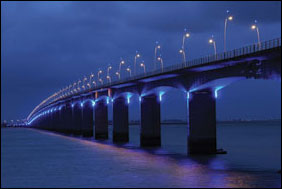For decades, LEDs have been lauded for their low power consumption to brightness ratio; but furthermore, the diodes offer greater design flexibility for dimming and color change than traditional lighting systems. It is these qualities that make LEDs ideal for applications such as outdoor lightning, dimmable street lighting, indoor ambient lighting and architectural lighting. With only a matter of time existing before LED centered lighting systems become most prolific, present lighting systems must adopt certain design characteristics in order to minimize cost and make the application market successful.

Wireless control is a key design aspect required in all modern LED lighting applications replacing traditional ones. Unfortunately, it is also the most expensive; since cost mitigation is a high priority on every firm’s agenda, solutions that reuse present infrastructure will be the first generation to permeate the market.
Solutions using the PLC technology of existing power lines can already accomplish this feat with minimal investment, since PLC allows long range communication. In addition, new OFDM-based PLC technology, such as the emerging G3-PLC standard, provide noise immunity and interoperability to simplify integration of lighting control.
Main design requirements
There are three primary design requirements that all system designers should strive to incorporate into wireless LED control systems. First of all, the communication range must befit the application. 30 meters is generally sufficient of a communication range for indoor application such as ambient lighting, but street lighting may require up to several miles/kilometers.
Secondly, the LED lamp must be energy efficient and consume the least power possible when the light is off, only communicating when the circuit is active. Lastly, the data rate of communication must be appropriate for the application. For example, localized lighting systems such in-house, require only a low bit rate to control dimming and read possible faults. But larger networks of lamps and architectural lighting may require data rates as large as 100 kbps.
Discrete or integrated MCU
Remote control systems require either a discrete microcontroller component or a microcontroller integrated in another IC. This MCU is responsible for decoding the communication protocol, generating dimming signals for the LED driver, reading faults, and controlling the lighting effects of the lamp, and often times a basic MCU is sufficient enough to do this, unless a complex communication protocol with a complex stack is involved.
Accurate energy measurement
It is a well-known fact that worldwide energy demand will increase at a rate that will likely exceed our ability to generate power, and improved energy management and comprehensive measurement systems are essential in giving users better visibility into their power consumption habits to eliminate consumer indifference to energy concerns. For this reason, including a form of accurate measurement system into outdoor lighting will also provide municipalities with additional tools for lowering power consumption through remote light dimming.
Via Maxim
Advertisement
Learn more about Maxim Integrated





